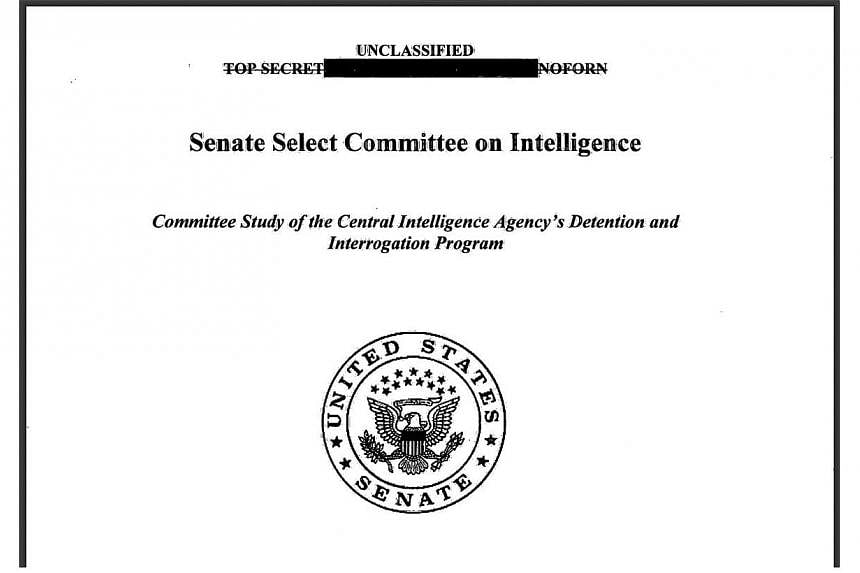The United States Senate has today declassified a section of the 6,000-page investigation into the interrogation and detentions carried out by the Central Intelligence Agency (CIA) in the wake of the Sept 11, 2001 attacks. It outlined a series of grave misconduct and a concerted attempt to keep political leaders, the media and the public in the dark.
Here are some of the more disturbing bits of the released report.
1. Freezing to death
Accused Afghan militant Gul Rahman died in a secret CIA prison in Afghanistan in November 2002 after being stripped and chained to the floor overnight. According to the report, Rahman was wearing only a sweatshirt because an officer, known only as CIA officer 1, had deemed him to have been uncooperative during an earlier interrogation.
Said the report: "The next day, the guards found Gul Rahman's dead body. An internal CIA review and autopsy assessed that Rahman likely died from hypothermia - in part from having to sit on the bare concrete floor without pants. (CIA officer 1's) initial cable to CIA headquarters on Rahman's death included a number of misstatements and omissions that were not discovered until internal investigations into Rahman's death."
The CIA officer involved was never reprimanded.
"Instead, in March 2003, just four months after the death of Gul Rahman, the CIA Station... recommended that (CIA officer 1) receive a 'cash award of US$2,500' for his 'consistently superior work'," said the report.
2. Torture of Abu Zubaydah
Abu Zubaydah is believed to have been a key ally to Al-Qaeda chief Osama bin Laden. The Senate report goes into some detail into the way Abu Zubaydah was interrogated while in custody.
He was held in a white cell with no natural light or windows and provided one of two chairs depending on his level of cooperation. One of the chairs was described as being more comfortable than the other.
The report added: "Either loud rock music was played or noise generators were used to enhance Abu Zubaydah's sense of hopelessness. Abu Zubaydah was typically kept naked and sleep deprived."
But worse was still to come. Over the course of a particularly aggressive 20-day period of interrogation, Abu Zubaydah was waterboarded two to four times a day and repeatedly locked in a coffin. Waterboarding involves pouring water over a person's face while he is covered up and tied. The tactic is said to give the victim the sensation of drowning.
"Abu Zubaydah spent a total of 266 hours (11 days 2 hours) in the large coffin-sized confinement box and 29 hours in a small confinement box, which had a width of 21 inches (53.34cm), a depth of 2.5 feet (6.4m) and a height of 2.5 feet. The CIA interrogators told Abu Zubaydah that the only way he would leave the facility was in the coffin-shaped confinement box," said the report.
At times, he became hysterical and also frequently "cried", "begged", "pleaded" and "whimpered", while continuing to deny he had any information on current threats. During one waterboarding session, he became "completely unresponsive, with bubbles rising through his open, full mouth". He remained unresponsive until given medical treatment.
The treatment of Abu Zubaydah was said to be so intense that some CIA personnel involved asked to be transferred while others began to question the legality of the process.
However, the then director of the Counter Terrorism Centre Jose Rodriguez dismissed these concerns.
"Strongly urge that any speculative language as to the legality of given activities or, more precisely, judgment calls as to their legality vis-a-vis operational guidelines for this activity agreed upon and vetted at the most senior levels of the agency, be refrained from in written traffic (email or cable traffic). Such language is not helpful," he said.
3. US prison officers "wowed" by conditions at CIA detention facility.
In November 2002, a delegation from the US Federal Bureau of Prisons conducted an assessment of a CIA detention facility and were reportedly "wowed" by what they saw.
"They have never been in a facility where individuals are so sensory deprived, i.e. constant white noise, no talking, everyone in the dark, with guards wearing a light on their head when they collected and escorted a detainee to an interrogation cell, detainees constantly being shackled to the wall or floor and the starkness of each cell (concrete and bars). There is nothing like this in the Federal Bureau of Prisons," said the report.
The delegation, however, did not apparently judge the treatment to be inhumane.
4. "Rectal rehydration" and other torture tactics.
Perhaps the most shocking torture tactic unveiled in the report was a practice known as rectal rehydration or rectal feeding. At least five detainees were subjected to the practice purely as a means to exert control over them.
As the report noted in the case of Khalid Sheikh Mohammad, one of the people accused of planning the Sept 11 attacks: "KSM (Khalid Sheikh Mohammad) was subjected to facial and abdominal slaps, the facial grab, stress positions, standing sleep deprivation (with his hands at or above head level), nudity, and water dousing. Chief of Interrogations also ordered the rectal rehydration of KSM without a determination of medical need, a procedure that the chief of interrogations would later characterise as illustrative of the interrogator's 'total control over the detainee'."
A similar procedure was also used on Guantanamo detainee Majid Khan.
Other tactics include intimidation with a gun and electric drill as well as sexual threats with a broomstick.
A section on the interrogation of Abd al-Rahim al-Nashiri, who allegedly masterminded the bombing of the USS Cole in Yemen, noted: "While blindfolded, an officer placed a pistol near Nashiri's head and operated a cordless drill near his body."
5. CIA misled public about the effectiveness of interrogation tactics
About half the report is focused on how the CIA actively misled the media about how effective their methods were. Despite evidence to the contrary, the CIA continually pushed the line that the interrogations had produced invaluable intelligence and saved lives.
In 2006, the CIA even helped edit a speech by then president George W. Bush to make it seem as if valuable information was gleamed from brutal interrogation tactics. The Senate report found that none of the CIA's most commonly cited success stories could be attributed to intelligence gained via its torture tactics.
For instance, one of the examples the CIA often uses to justify its interrogation was the capture of Hambali, a key Jemaah Islamiyah leader. Yet, in the CIA's own records, the chief of the Counter Terrorism Centre South-east Asia branch said the capture was down to pure luck.
He said: "Frankly, we stumbled onto Hambali... It wasn't police work, it wasn't good targeting, it was we stumbled over it and it yielded Hambali. What I tell my people is you work really, really hard to be in a position to get lucky."


